Geochemical Characteristics and Depositional Environment from the Permian Qipan Formation Hydrocarbon Source Rocks in the Piedmont of Southwestern Tarim Basin
Abstract
:1. Introduction
2. Geological Background
3. Materials and Methods
3.1. TOC and Pyrolysis Analysis
3.2. Vitrinite Reflectance and Reflected Light Microscopy
3.3. Main and Trace Element Analysis
3.4. Gas Chromatography–Mass Spectroscopy (GC–MS)
4. Results
4.1. Petrological Characteristics by Field Observations
4.1.1. Qimeigan Outcrop Section
- (1)
- The thickness of the first member is 200.24 m, and the lithology is dominated by frequent unequal thick interbedding of dark gray mudstone, dark gray carbonate rock, and gray green sandstone (Figure 5a). In the middle of the section, there is dark gray or gray black mudstone, which is a great hydrocarbon source rock (Figure 5b).
- (2)
- The second member is 191.48 m thick and is dominated by limestone, with a small amount of mudstone. The limestones are primarily composed of micrite bioclastic limestone and mudstone limestone (Figure 5c). The limestones are dark in color, and parallel-bedding or cross-bedding is observed in the interior. This member can be attributed to the process of normal marine sedimentation. The limestones with a high mudstone content are indicative of the beach-interacting sea sedimentary environment, whereas the limestone dominated by sparry calcite cementation is representative of various open platform sedimentation, which is predominantly biodetritus beach.
- (3)
- The stratigraphy of the third member is 157.39 m thick, and the lithology is mainly mudstone interbedded with thinly bedded sandstone. The sandstone is mostly argillaceous siltstone (Figure 5d). Three sets of basalts, exhibiting a grayish green coloration, are exposed at the bottom and top of the member, reaching a thickness of up to 61.58 m. The mudstones are dark gray in color and thinly bedded, and are interpreted as continental shelf deposit. The basalt was formed by a submarine volcanic eruption, which is an effusion facies. The size of the volcanic breccia is mostly between 2 and 7 cm, with a maximum of 20 cm.
- (4)
- The fourth member is 438.2 m thick and is dominated by clastic sedimentary rocks, with a small amount of carbonate rocks. Mudstone is gray in color (Figure 5e), while sandstone is grayish green, comprising fine-grained debris sandstone and limy siltstone. The material in question can be attributed to the deltaic environment, where it forms a set of lithological assemblages of delta front and prodelta interactive deposition.
4.1.2. Qiemugan Outcrop Section
- (1)
- The thickness of the first member is 35.92 m, with the bottom comprising mudstone limestone (Figure 5f). The formation comprises some dark gray calcareous mudstones, which contain sandstone bands (Figure 5g). The micrite structure is composed primarily of calcite, with a minor component of bioclastic fragments. The upper part of the member comprises sandstone and mudstone, which were deposited by the front edge of the braided river delta front and underwater distributary channel.
- (2)
- The second member is 40.52 m thick, with the lower part comprising gray black carbonaceous mudstone mingled with gray fine sandstone. This is deposited in the former prodelta. The middle part is a combination of yellow green siltstone, gray green argillaceous siltstone, and gray green fine sandstone (Figure 5h), with reverse grain sequence, which is deposited in braided river delta front and underwater distributary channel. The upper part of the lithological assemblage is essentially identical to the lower part.
- (3)
- The thickness of the third stratigraphic member is 91.05 m. The upper part of the lithographic assembly is essentially the same as the lower part. In the middle part of the member, there is a layer of yellow green fine sandstone, which transforms upwards to dark gray mudstone (Figure 5i) interbedded with sandstone and argillaceous siltstone (Figure 5j). In the upper part, there is a thin layer of dark mudstone interbedded with argillaceous siltstone, and a set of greenish gray fine sandstone is developed about 50 m away from the top of this section, in a positive grained sequence. The entire member can be attributed to the sedimentary system of the front edge of braided river delta front and prodelta. The braided river delta front is characterized by the deposition of mudstone, while prodelta is marked by the deposition of sandstone.
- (4)
- The fourth member is 129.84 m thick and is dominated by clastic rocks, including gray green fine sandstone, gravel-bearing coarse sandstone, and purplish red fine sandstone. These are interspersed with light gray thinly medium sandstone. The formation of large cross-bedded and parallel-bedded rocks is observed. The clastic rock was dominated by sandstone, conglomerate, and gravel-bearing coarse sandstone, while the gravel component is dominated by volcanic rocks. The top of the rocks develops lacustrine carbonate rocks.
4.1.3. Akeqi Outcrop Section
4.2. TOC and Tock-Eval Pyrolysis Evaluation
4.3. Kerogen Type and Maturation
4.4. GC–MS Biomarker Analysis
5. Discussion
5.1. Source Rock Evaluation
5.2. Sources of Organic Matter
6. Conclusions
- (1)
- The organic matter abundance of the hydrocarbon source rocks of the Permian Qipan Formation in the piedmont of southwestern Tarim Basin was evaluated as medium–good hydrocarbon source rocks. The hydrocarbon source rocks are mature, with the organic matter having reached a stage of high or over-mature evolution. The koregen types are predominantly Type III, Type II2, and a portion Type I.
- (2)
- The sedimentary waters of the hydrocarbon source rocks of the Permian Qipan Formation in the piedmont of southwestern Tarim Basin are predominantly oxygen-rich, with a lesser degree of anoxia. The salinity of the water bodies is comparable and high in semi-saline environments. The detrital material that formed the hydrocarbon source rocks of the Qipan Formation was derived from an unstable source and originated from an amphibolite environment. This also indicates that the organic matter types of the hydrocarbon source rocks of the Qipan Formation exhibit differences depending on the depositional environment.
- (3)
- The type of organic matter present in the hydrocarbon source rocks varies due to differences in the depositional environments. The depositional environments in the vicinity of Wuqia County are predominantly marine, comprising open continental shelf facies, slope facies, and shore facies. The organic matter present is predominantly Type I, with a minor component Type II. In the vicinity of the Qiemugan section in the northwestern of the Kashi sag, the lagoon facies, the shore facies, and fan delta facies are developed. The organic matter is mostly of mixed source, mainly of Type II. In addition to marine environments such as lagoon facies and shore facies, the southwestern part in the piedmont of southwestern Tarim Basin also developed sea–land transitional phase deposits such as fan deltas facies and barrier facies. Influenced by terrestrial sources of organic matter, Type II and some Type III organic matter were formed.
Author Contributions
Funding
Institutional Review Board Statement
Informed Consent Statement
Data Availability Statement
Conflicts of Interest
References
- Liu, C.P.; Luo, L.; Qi, J.F.; Yu, H.Z. Geological and Hydrocarbon Accumulation Characteristics in Piedmont Zone. Geosicience 2013, 10, 1034–1041. [Google Scholar]
- He, D.F.; Zhao, W.Z. Dynamic Evolution of Sedimentary Basins and Petroleum System Cycles in Northwest China; Petroleum Industry Press: Beijing, China, 1999; pp. 1–181. [Google Scholar]
- Zhao, M.J.; Xia, X.F.; Qin, S.F.; Song, Y. Gas Source Study of Ake Well 1 Resource in Tarim Basin. Nat. Gas Ind. 2003, 23, 31–33. [Google Scholar]
- Xiao, Z.Y.; Tang, Y.J.; Hou, D.J.; Zhang, Q.C. Study on Oil Source of Kekeya Condensate Oil-Gas Pool. Acta Sedimentol. Sinic. 2002, 20, 716–720. [Google Scholar]
- Hou, D.J.; Xiao, Z.Y.; Tang, Y.J.; Zhu, J.Z.; Li, X.Q. Geochemical Characterization of Mixing Natural Gas in Kekeya Field, Tarim Basin, China. Nat. Gas Geosci. 2003, 14, 474–479. [Google Scholar]
- Du, J.H.; Wang, Z.M.; Lei, G.L.; Hu, J.F. A Discovery in Well Kedong-1 and Its Exploration Significance. Explor. Strategy 2011, 16, 1–5. [Google Scholar]
- Yang, H.J.; Wang, B.Q.; Yang, Z.L.; Lei, G.L.; Wei, H.X. Structure modeling and hydrocarbon exploration of Kedong structural belt in southwestern Tarim Basin. Chin. J. Geol. 2011, 46, 456–465. [Google Scholar]
- He, D.F.; Li, D.S.; He, J.Y.; Wu, X.Z. Comparison in petroleum geology between Kuqa depression and Southwest depression in Tarim Basin and its exploration significance. Acta Pet. Sin. 2013, 34, 201–214. [Google Scholar]
- Wang, Q.; Peng, P.A.; Zeng, J.; Zou, Y.R. Oil source of condensates from Well Kedong 1 and crude oil from Kekeya in Yecheng depression. Geochimica 2014, 34, 470–476. [Google Scholar]
- Du, Z.L.; Zeng, C.M.; Qiu, H.J.; Yang, Y.X.; Zhang, L. Key Formation of the Permian Hydrocarbon source rocks and Oil-Source Correlation of well KD1 in Yecheng Depression of Southwestern Tarim Basin. J. Jilin Univ. Earth Sci. Ed. 2016, 46, 652–659. [Google Scholar]
- Huang, W.Y.; Pan, C.C.; Yu, S.; Zang, H.Z.; Xiao, Z.Y. Oil source and charging process of Well FS4 in the Kedong structural belt, Southwest Tarim Basin Depression. Nat. Gas Geosci. 2022, 33, 1837–1847. [Google Scholar]
- Wang, Q.H.; Xu, Z.P.; Zhang, Y.H.; Yang, H.J.; Yang, X.Z. New fields, new types of hydrocarban explorations and their resource potentials in Tarim Basin. Acta Pet. Sin. 2024, 45, 15–29. [Google Scholar]
- Wang, Q.H.; Yang, H.J.; Li, Y.; Cai, Z.Z.; Yang, X.Z. Major breakthrough in the Carboniferous-Permian in Well Qiatan 1 and exploration prospect in the piedmont southwestern Tarim Basin. China Pet. Explor. 2023, 28, 34–44. [Google Scholar]
- Venkatesan, M.I.; Kaplan, I.R. The lipid geochemistry of antarctic marine sediments: Bransfield strait. Mar. Chem. 1987, 21, 347–375. [Google Scholar]
- Makky, A.F.; El Sayed, M.I.; El-Ata, A.S.A.; Abd El-Gaied, I.M.; Abdel-Fattah, M.I.; AbdAllah, Z.M. Source rock evaluation of some upper and lower cretaceous sequences, West Beni Suef concession, Western Desert, Egypt. Egypt. J. Petrol. 2014, 23, 135e149. [Google Scholar]
- Rocha, Y.S.; Rosana, C.; Lopes, P.; Joao, G.M.F. Geochemical assessment of oils from the mero field, Santos basin, Brazil. Org. Geochem. 2019, 130, 1–13. [Google Scholar]
- Soliman, S.R.; Salama, Y.F.; El-Sayed, M.I.; Abdel-Fattah, M.I.; Abd-Allah, Z.M. Assessment of mineralogical and geochemical composition of oligocene/eocene black shale deposits in beni suef area, Egypt. Adv. Mater. Sci. Eng. 2022, 2022, 1606431. [Google Scholar]
- El-Shafeiy, M.; Birgel, D.; El-Kammar, A.; El-Barkooky, A.; Wagreich, M.; Mohamed, O.; Peckmann, J. Palaeoecological and post-depositional changes recorded in campanian-maastrichtian black shales, abu tartur plateau, Egypt. Cretac. Res. 2014, 50, 38–51. [Google Scholar]
- Abd-Allah, Z.M.; Abdullah, W.H.; Abdel-Fattah, M.I. Assessment of Eocene, Paleocene and cretaceous source rocks in the west Feiran area, offshore Gulf of Suez, Egypt. J. Pet. Sci. Eng. 2019, 180, 756–772. [Google Scholar]
- Peters, K.E.; Walters, C.C.; Moldowan, J.M. The Biomarker Guide, Biomarkers and Isotopes in Petroleum Exploration and Earth History; CUP: New York, NY, USA, 2005; Volume 2, p. 1155. [Google Scholar]
- Saito, H.; Suzuki, N. Distributions and sources of hopanes, hopanoic acids and hopanols in miocene to recent sediments from ODP leg 190, nankai trough. Org. Geochem. 2007, 38, 1715–1728. [Google Scholar] [CrossRef]
- Thiel, V.; Hoppert, M. Fatty acids and other biomarkers in two early jurassic concretions and their immediate host rocks (lias δ buttenheim clay pit, bavaria, Germany). Org. Geochem. 2018, 120, 42–55. [Google Scholar] [CrossRef]
- Wang, J.B.; Gao, Z.Q.; Kang, Z.H.; Yang, Y.X.; Wei, R.; Qin, N.T. The sedimentary environment and geochemical characteristics of the source rocks in the Pusige Formation Sag, southwestern Tarim Basin, China. Nat. Gas Geosci. 2017, 28, 1723–1732. [Google Scholar]
- Hou, Q.D.; Ren, S.M.; Guo, T.X.; Zhou, Z.; Jin, J.H. Analysis of Geological Conditions of Permian Shale Oil and Gas in the Southwestern Depression of the Tarim Basin, Northwest China. Northwest. Geol. 2020, 53, 168–176. [Google Scholar]
- Liu, J.; Tian, L.; Yang, L.S.; Dai, D.D.; Zang, J.J. Particularity of Paleozoic hydrocarbon accumulation conditions in the Southwest Tarim Depression and its implications for petroleum exploration. Nat. Gas Ind. 2023, 43, 61–70. [Google Scholar]
- Cheng, X.G.; Huang, Z.B.; Chen, H.L.; Du, Z.L.; Li, K. Fault characteristics and division of tectonic units of the thrust belt in the front of the West Kunlun Mountains. Acta Petrol. Sin. 2012, 28, 2591–2601. [Google Scholar]
- Fang, W.X.; Wang, L.; Lu, J.; Li, T.C.; Jia, R.X. Mesozoic-Cenozoic Sedimentary Basin, Foreland Fold-and-Thrust Meralization Reglarities of Copper-lead-zinc-celesite-uranium-coal in Wulagen, Xinjiang, China. Geotecton. Metallog. 2020, 44, 882–908. [Google Scholar]
- Xie, X.M.; Hu, X.; Wang, Z.H.; Zhao, Y.; Xiao, Q.L. Geochemical characteristics and depositional environment of two sets of hydrocarbon source rocks in Qimeigan section, Permian system, Southwest Tarim Basin. J. Yangte Univ. Nat. Sci. Ed. 2024. [Google Scholar]
- Han, H.Y.; Kang, Z.H.; Deng, P.; Fu, K.N.; Qin, N.T. Comprehensive Analysis of Sedimentary Characteristics of Qipan Formation in Southwest Margin of Tarim Basin. Coal Technol. 2018, 37, 122–124. [Google Scholar]
- Behar, F.; Beaumont, V.; Penteado, H.L.D.B. RockEval 6 technology: Performances and developments. Oil Gas Sci. Technol. 2001, 56, 111–134. [Google Scholar] [CrossRef]
- Carvajal-Ortiz, H.; Gentzis, T. Critical considerations when assessing hydrocarbon plays using Rock-Eval pyrolysis and organic petrology data: Data quality revisited. Int. J. Coal Geol. 2015, 152, 113–122. [Google Scholar] [CrossRef]
- Mukhopadhyay, P.K.; Hatcher, P.G. Composition of Coal. In Hydrocarbons from Coal; Law, B.E., Rice, D.D., Eds.; American Association of Petroleum Geologists: Oklahoma City, OK, USA, 1993; Volume 36, pp. 79–118. [Google Scholar]
- Law, C.A. Evaluating Source Rocks. In Treatise Petroleum Geology/Handbook of Petroleum Geology: Exploring for Oil and Gas Traps; Beaumont, E.A., Foster, N.H., Eds.; American Association of Petroleum Geologists: Oklahoma City, OK, USA, 1999; pp. 6–41. [Google Scholar]
- Wilkins, R.W.T.; George, S.C. Coal as a source rock for oil: A review. Int. J. Coal Geol. 2002, 50, 317–361. [Google Scholar] [CrossRef]
- Philp, R.P.; Lewis, C.A. Organic geochemistry of biomarkers. Annu. Rev. Earth Planet Sci. 1987, 15, 363–395. [Google Scholar] [CrossRef]
- SY/T 5124-2012; Method for Determining Microscopically the Reflectance of Vitrinite in Sedimentary. China Research Institute of Petroleum Exploration and Development: Beijing, China, 2012.
- SY/T 6414-2014; Maceral Identification and Statistical Methods on Polished Surfaces of Whole Rocks. China Research Institute of Petroleum Exploration and Development: Beijing, China, 2014.
- GB/T 14506.30-2010; Methods for chemical analysis of silicate rocks—Part 30: Determination of 44 elements. SAC: Beijing, China, 2010.
- GB/T 14506.28-2010; Methods for chemical analysis of silicate rocks—Part 28: Determination of 16 major and minor elements content. SAC: Beijing, China, 2010.
- Simoneit, B.R.T. Molecular indicators (biomarkers) of past life. Anat. Rec. 2002, 268, 186–195. [Google Scholar] [CrossRef] [PubMed]
- Moustafa, Y.M.; Morsi, R.E. Biomarkers. In Chromatography and its Applications; Dhanarasu, S., Ed.; InTechOpen: London, UK, 2012; pp. 165–186. [Google Scholar]
- Peters, K.E.; Moldowan, J.M.; Schoell, M.; Hempkins, W.B. Petroleum isotopic and biomarker composition related to source rock organic matter and depositional environment. Org. Geochem. 1986, 10, 17–27. [Google Scholar] [CrossRef]
- Awan, R.S.; Liu, C.; Gong, H.; Dun, C.; Tong, C.; Chamssidini, L.G. Paleo-sedimentary environment in relation to enrichment of organic matter of early Cambrian black rocks of Niutitang formation from Xiangxi area China. Mar. Pet. Geol. 2020, 112, 104057. [Google Scholar] [CrossRef]
- Peters, K.E. Guidelines for evaluating petroleum source rock using programmed pyrolysis. AAPG Bull. 1986, 70, 318–329. [Google Scholar]
- Peters, K.E.; Cassa, M.R. Applied Source Rock Geochemistry. In The Petroleum System—From Source to Trap; Magoon, L.B., Dow, W.G., Eds.; American Association of Petroleum Geologists: Tulsa, OK, USA, 1994; Memoir 60; pp. 93–120. [Google Scholar]
- Burton, Z.; Dafov, L.N. Testing the sediment organic contents required for biogenic gas hydrate formation: Insights from synthetic 3-D basin and hydrocarbon system modelling. Fuels 2022, 3, 555–562. [Google Scholar] [CrossRef]
- Waples, D.W. Geochemistry in Petroleum Exploration; International Human Resources Development Corporation: Boston, MA, USA, 1985; p. 232. [Google Scholar]
- Baskin, D.K. Atomic H/C ratio of kerogen as an estimate of thermal maturity and organic matter conversion. AAPG Bull. 1997, 81, 1437–1450. [Google Scholar]
- Gonzalez, M.B.; Barrionuevo, S.; Peralba, C.M.; Kalkreuth, W. Geochemical characterization of Jurassic source rocks from Cuba: 2 Constancia formation in onshore Varadero oils fields. Energy Explor. Exploit. 2014, 32, 847–872. [Google Scholar] [CrossRef]
- Shi, J.P.; Zhao, C.Y.; Liu, H.T.; Li, C.M. Discussion on several problems about source-rock evaluation. Nat. Gas Explor. Dev. 2021, 44, 13–21. [Google Scholar]
- Tissot, B.P.; Welte, D.H. Petroleum Formation and Occurrence, 2nd ed.; Springer: New York, NY, USA, 1984; p. 699. [Google Scholar]
- Awan, R.S.; Liu, C.; Aadil, N.; Yasin, Q.; Salaam, A.; Hussain, A.; Yang, S.; Jadoon, A.K.; Wu, Y.; Gul, M.A. Organic geochemical evaluation of cretaceous Talhar shale for shale oil and gas potential from lower Indus Basin, Pakistan. J. Pet. Sci. Eng. 2021, 200, 108404. [Google Scholar] [CrossRef]
- Gao, G.; Titi, A.; Yang, S.; Tang, Y.; Kong, Y.; He, W. Geochemistry and depositional environment of fresh lacustrine source rock: A case study from the Triassic Baijiantan formation shales in Junggar Basin, northwest China. Org. Geochem. 2017, 113, 75–89. [Google Scholar]
- Armagnac, C.; Bucci, J.; Kendall, G.; Lerche, I. Estimating the Thickness of Sediment Removed at an Unconformity Using Vitrinite Reflectance Data; Springer: New York, NY, USA, 1989; pp. 217–238. [Google Scholar]
- Lerche, I.; Yarzab, R.F.; Kendall, C. Determination of paleoheat flux from vitrinite reflectance data. AAPG Bull. 1984, 68, 1704–1717. [Google Scholar]
- Volkman, J.K.; Maxwell, J.R. Acyclic Isoprenoids as Biological Markers. In Biological Markers in the Sedimentary Record; Johns, R.B., Ed.; Elsevier: Amsterdam, The Netherlands, 1986. [Google Scholar]
- El-Mansey, I.M.; Shehata, M.G.; Massoud, M.A.; Awad, S.A. Geochemical studies on subsurface Paleozoic Sediments from some wells in Siwa-Faghur basin, Western Desert, Egypt. Egypt. J. Petrol. 2004, 13, 91–106. [Google Scholar]
- Mamdouh, M.; Reda, M.; Raef, A.; Zein El Din, M.Y.; Abdelhafeez, T.H.; AlHashim, M.H. Reservoir Quality, Lithotypes Assessment, and Geochemical Source Rocks Analysis: Insights from Well Logs and Pyrolysis Data, Karama Field. North-Western Desert, Egypt. Geofluids 2024, 2024, 1235792. [Google Scholar]
- Hunt, J.H. Petroleum Geochemistry and Geology; W.H. Freeman: San Francisco, CA, USA, 1979; p. 617. [Google Scholar]
- Wang, J.B. Geochemical Characteristics of Source Rocks of the Jurassic Poplar Leaf Formation in the Kashgar sag in Southwest Taxi; China University of Geosciences: Beijing, China, 2017. [Google Scholar]
- Huang, Z.S.; Wang, X.Z.; Yang, X.Y. Constraints of sedimentary environment on organic matter enrichment in shale: A case study of Wufeng Formation-Longmaxi Formation in southern Shunan. J. Sedimentol. 2021, 39, 631–644. [Google Scholar]
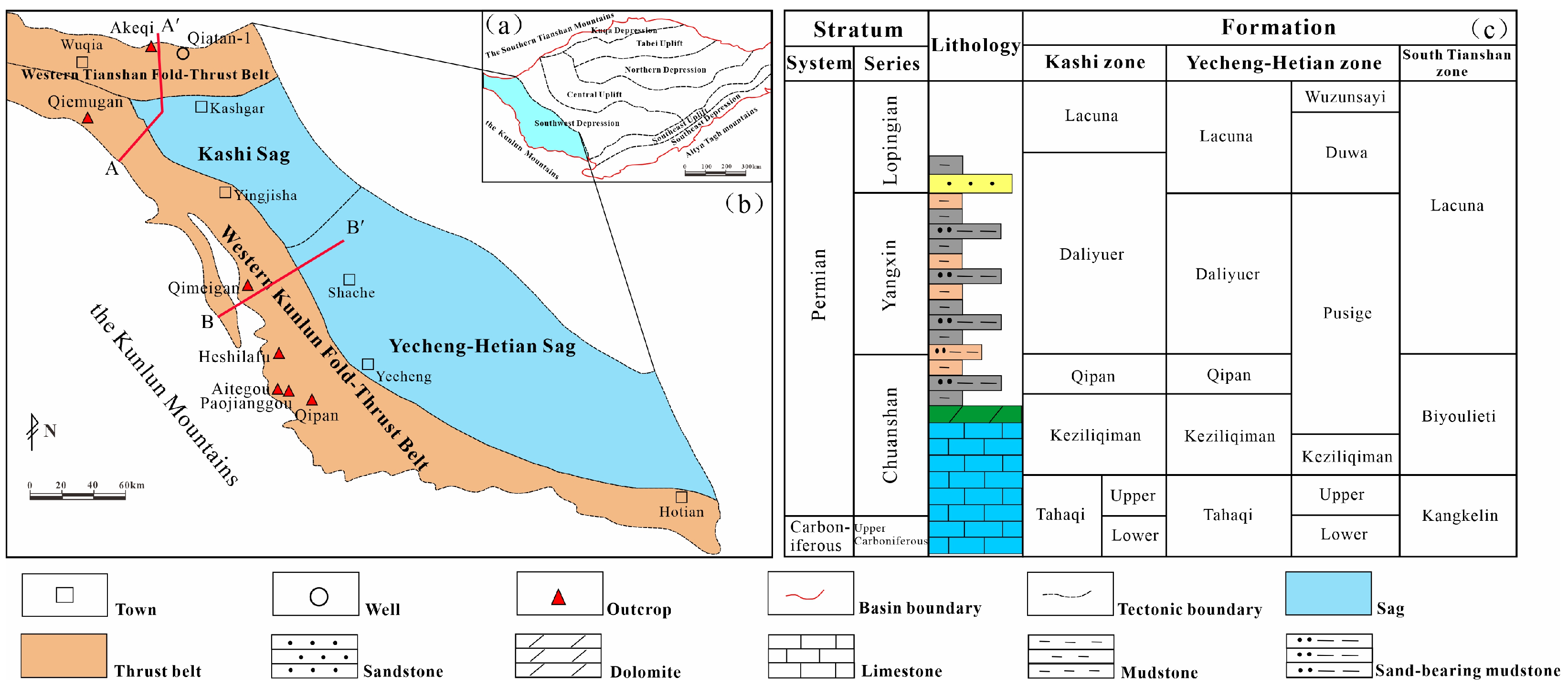
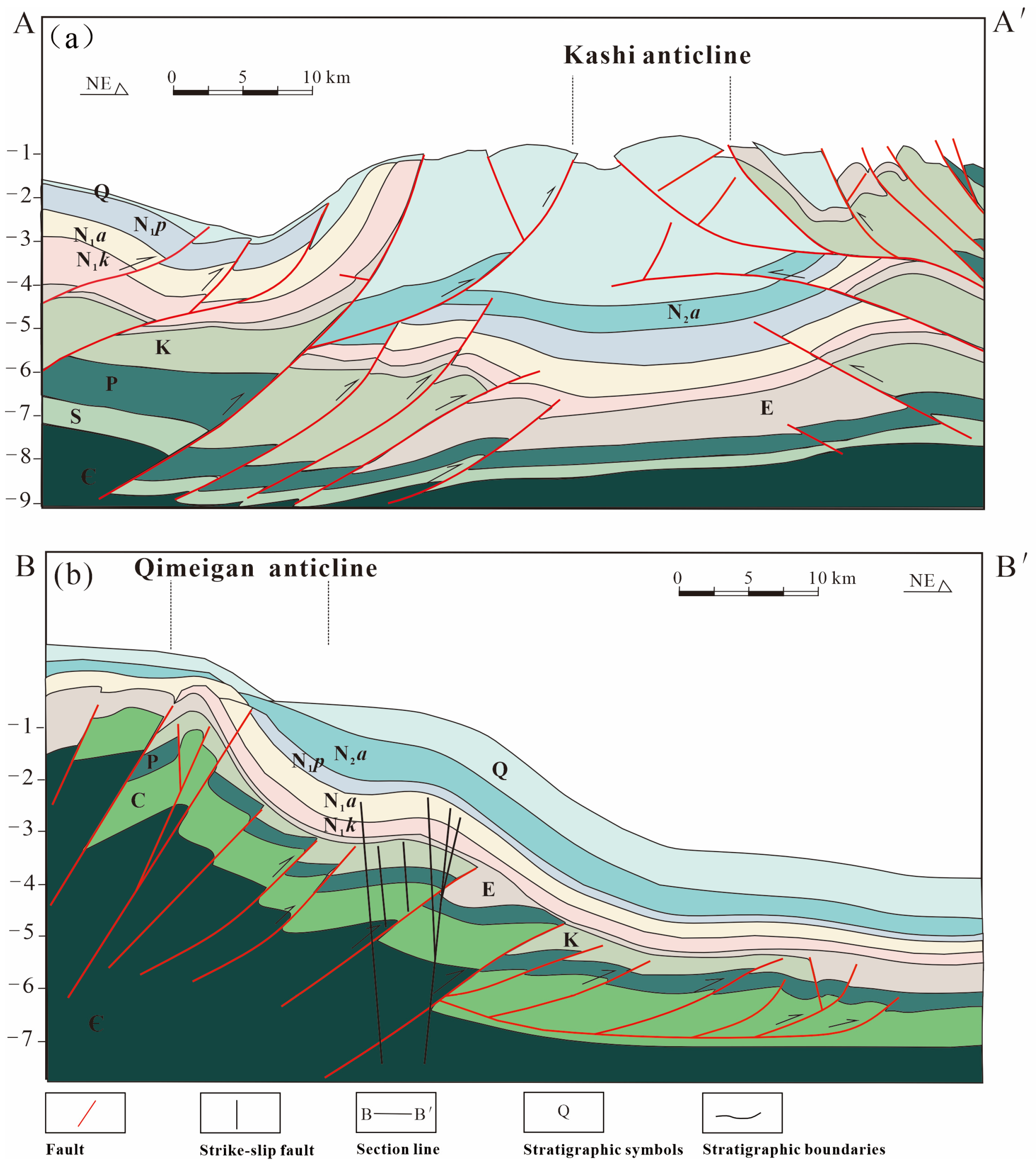
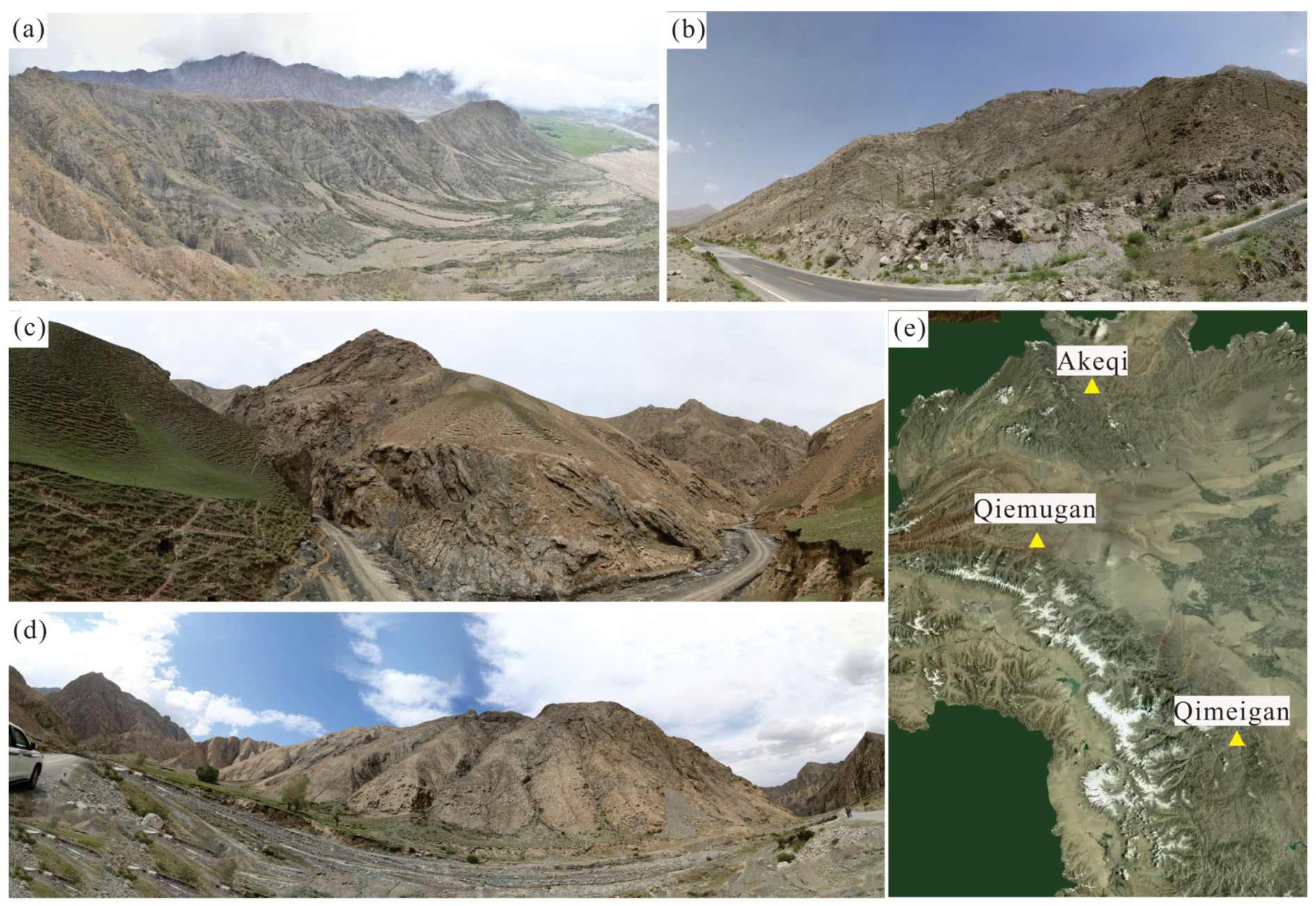
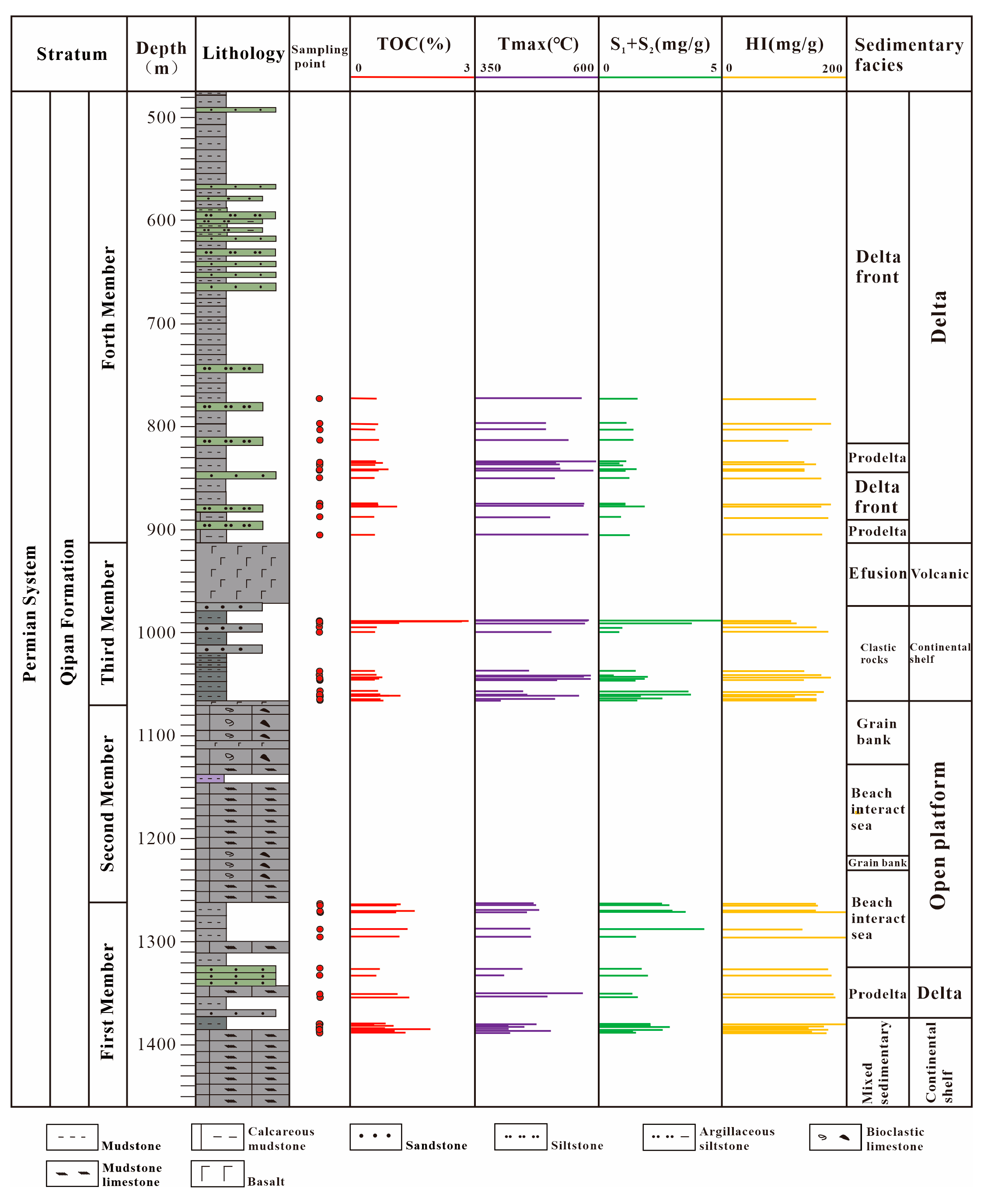
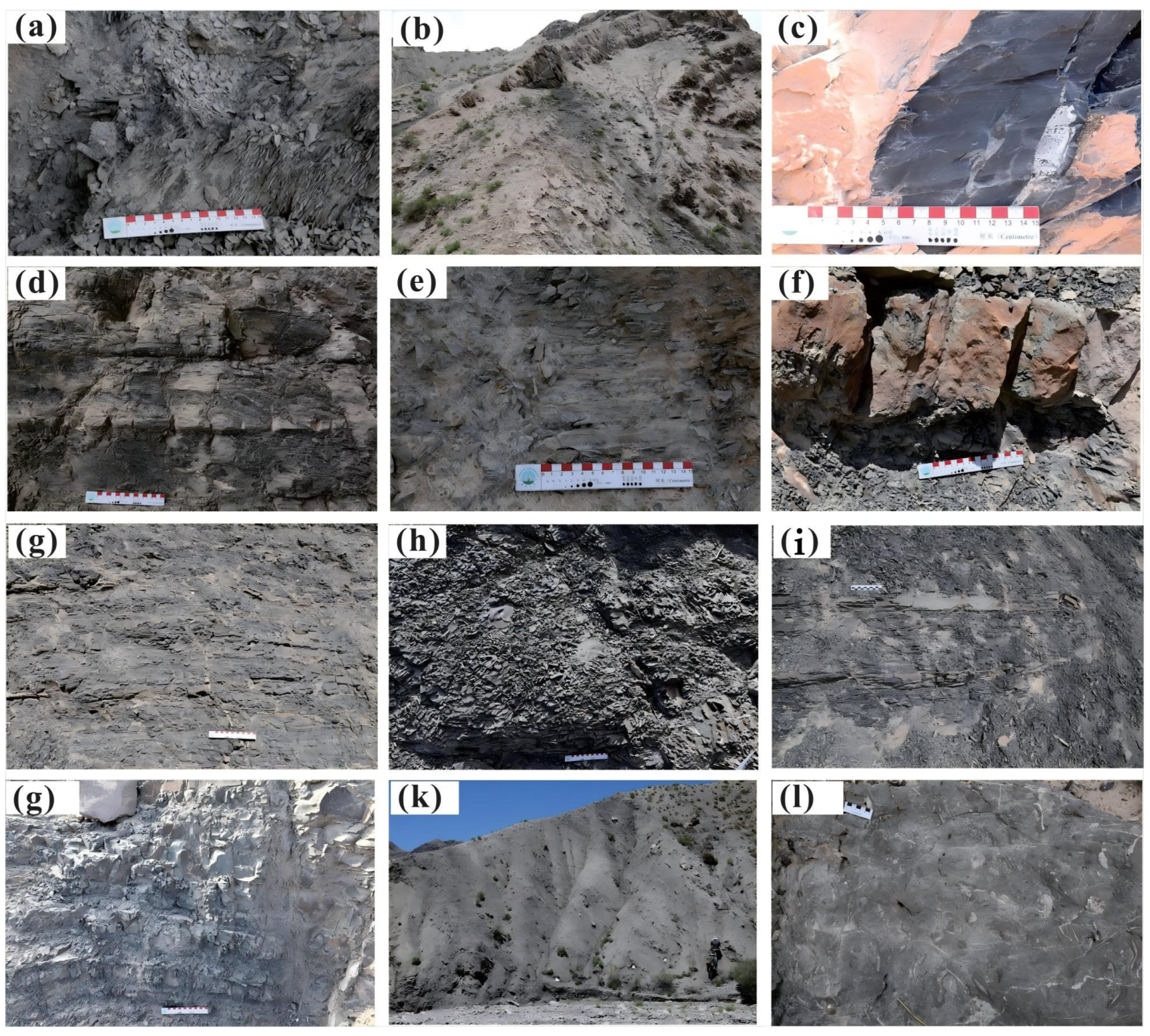


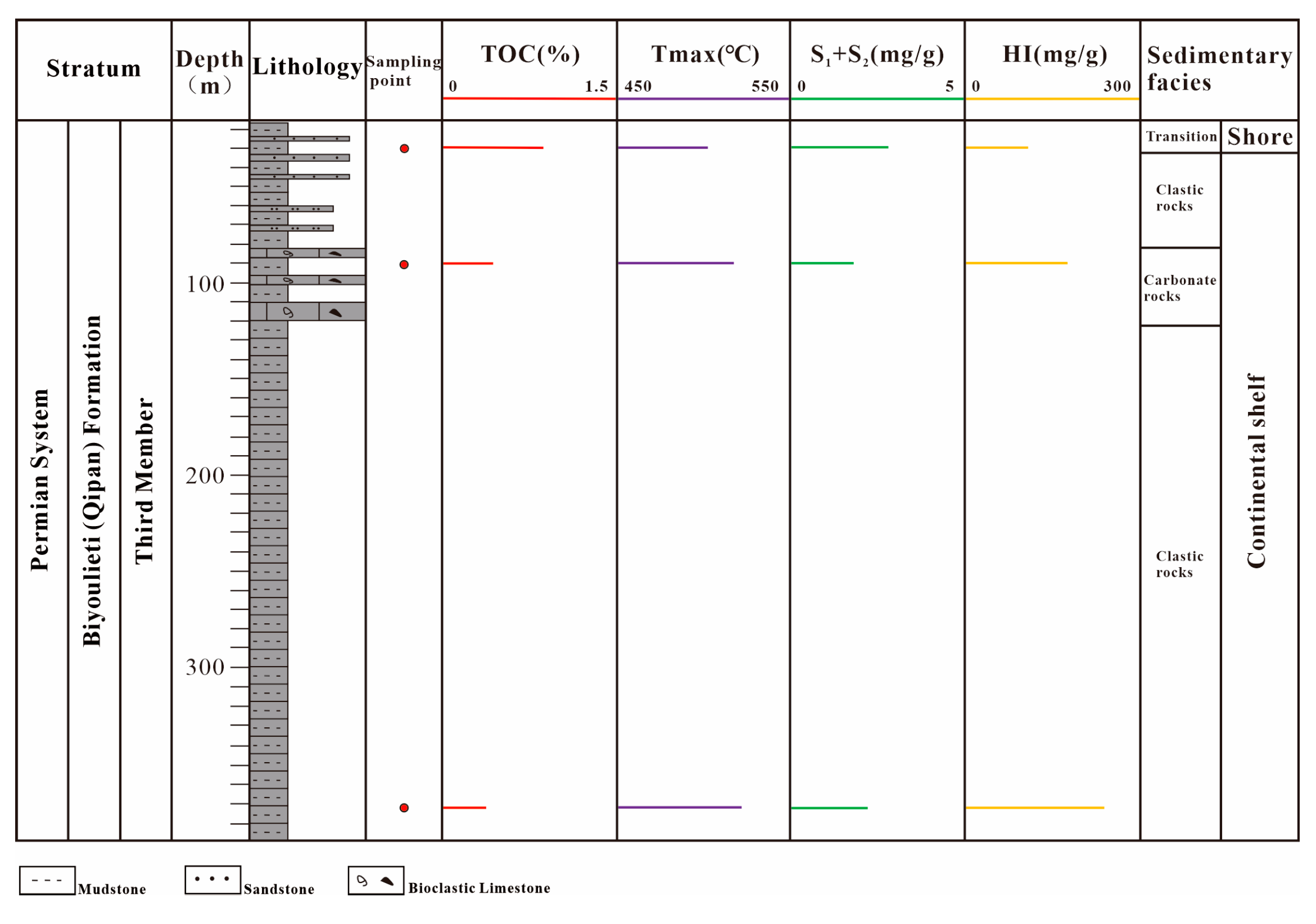
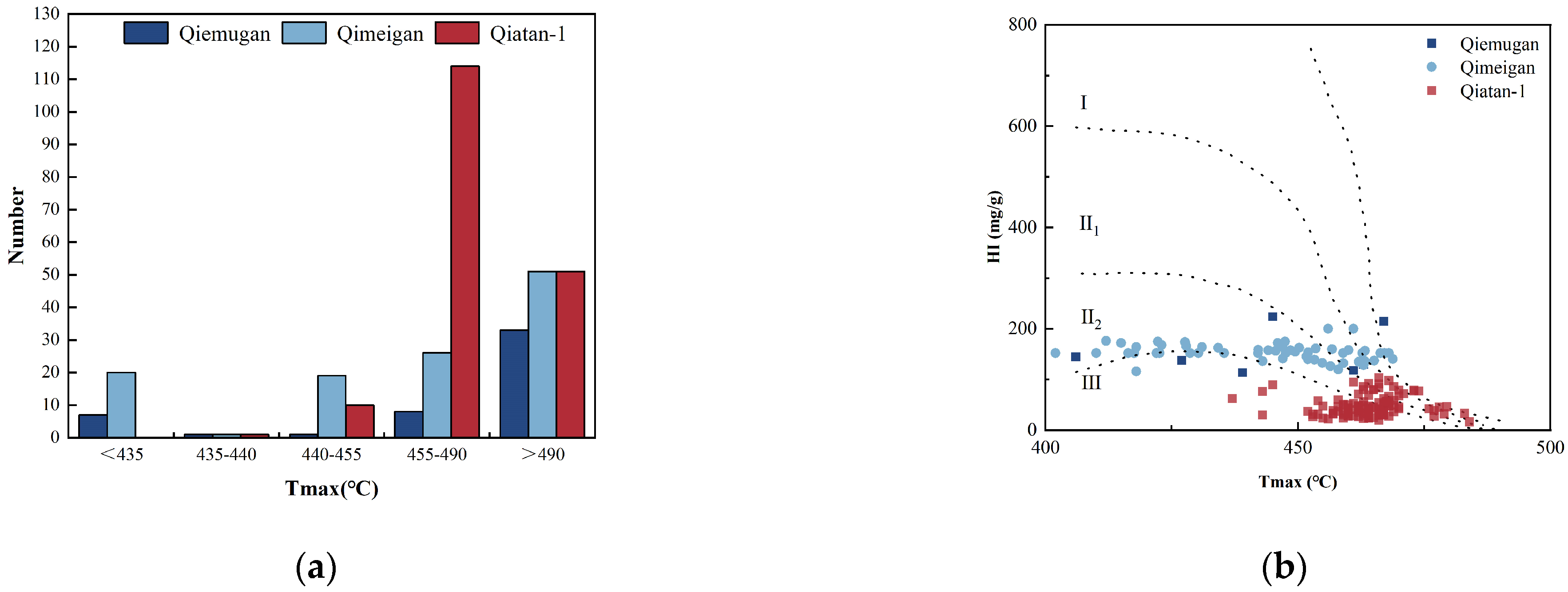
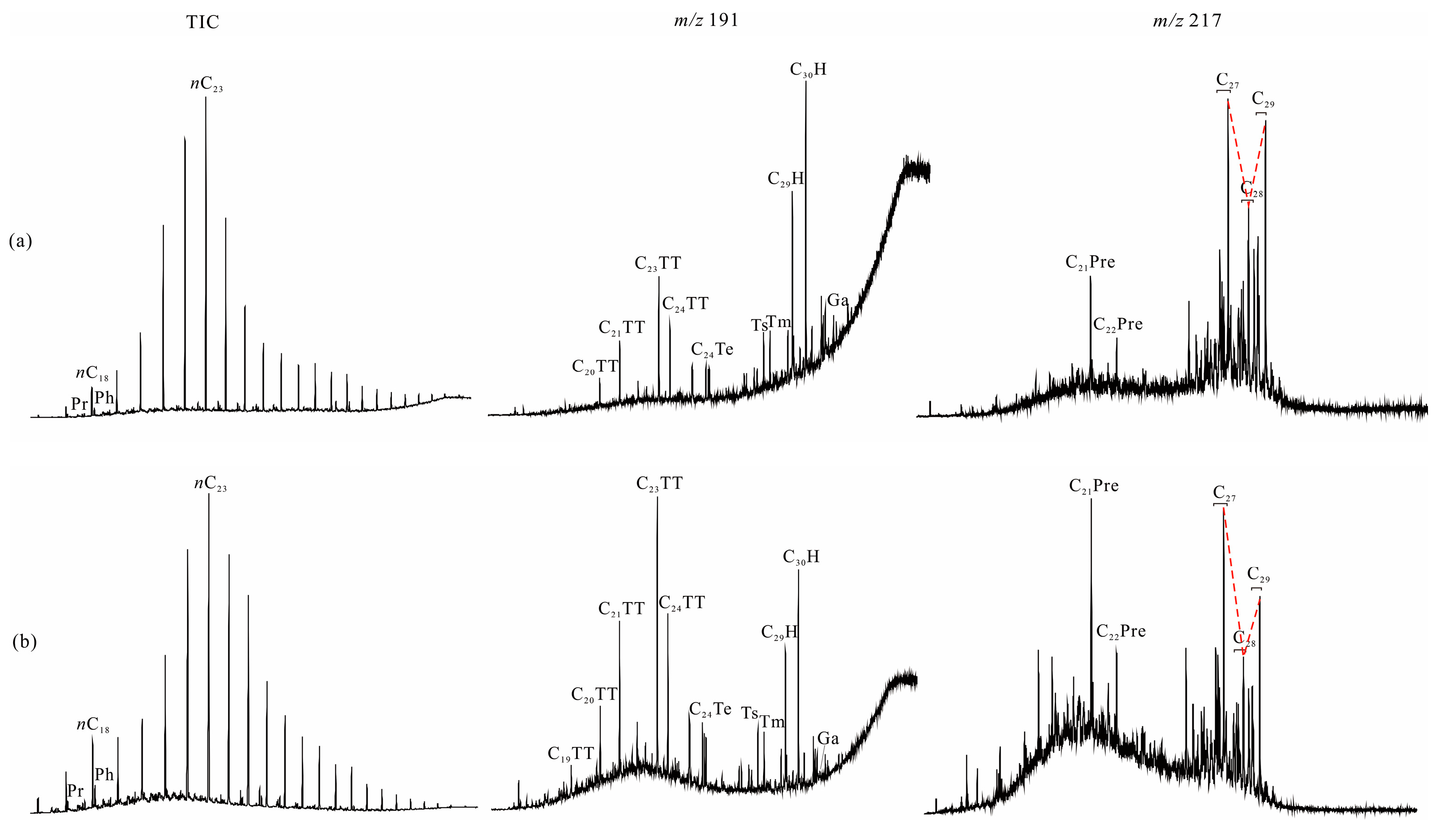

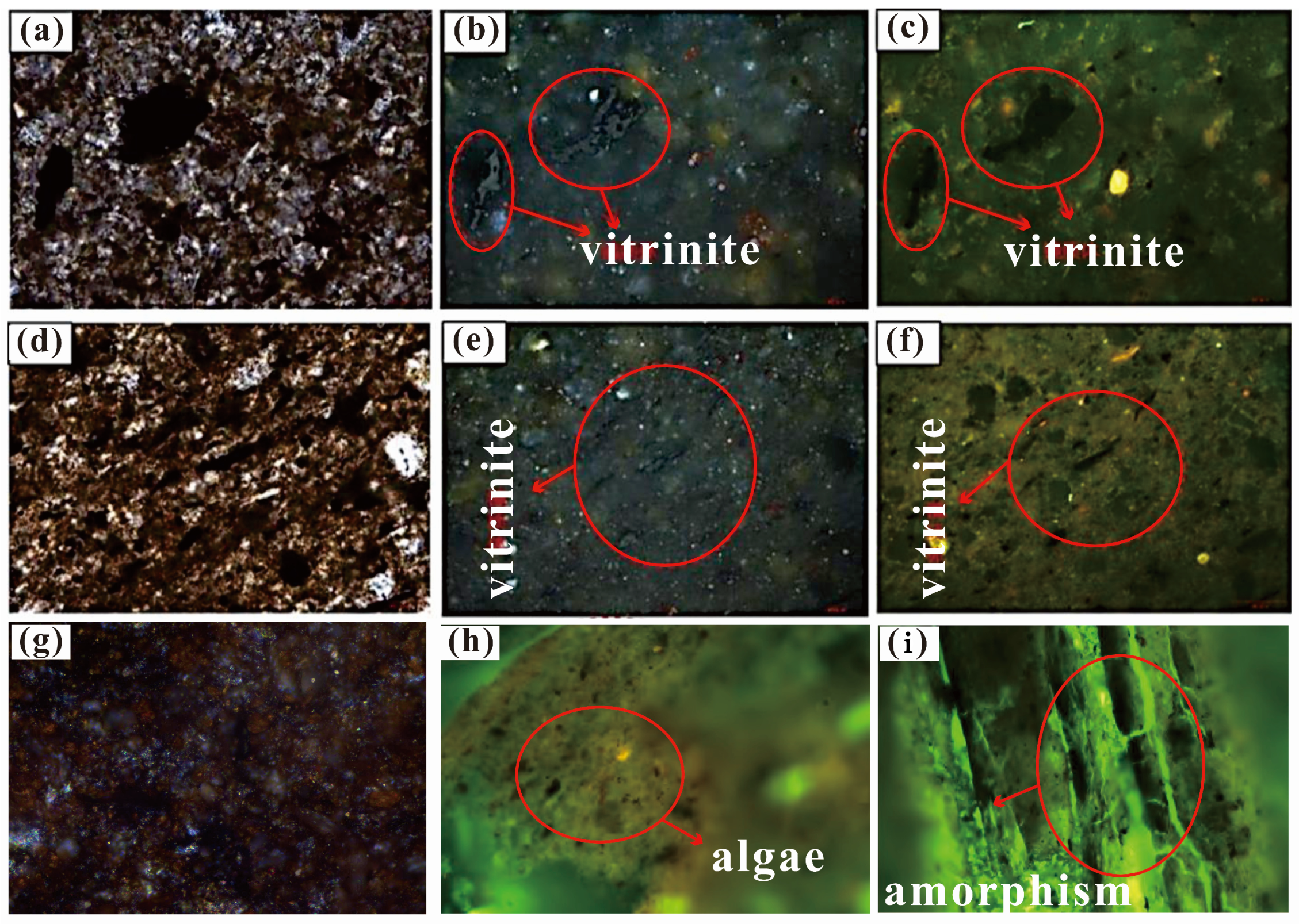
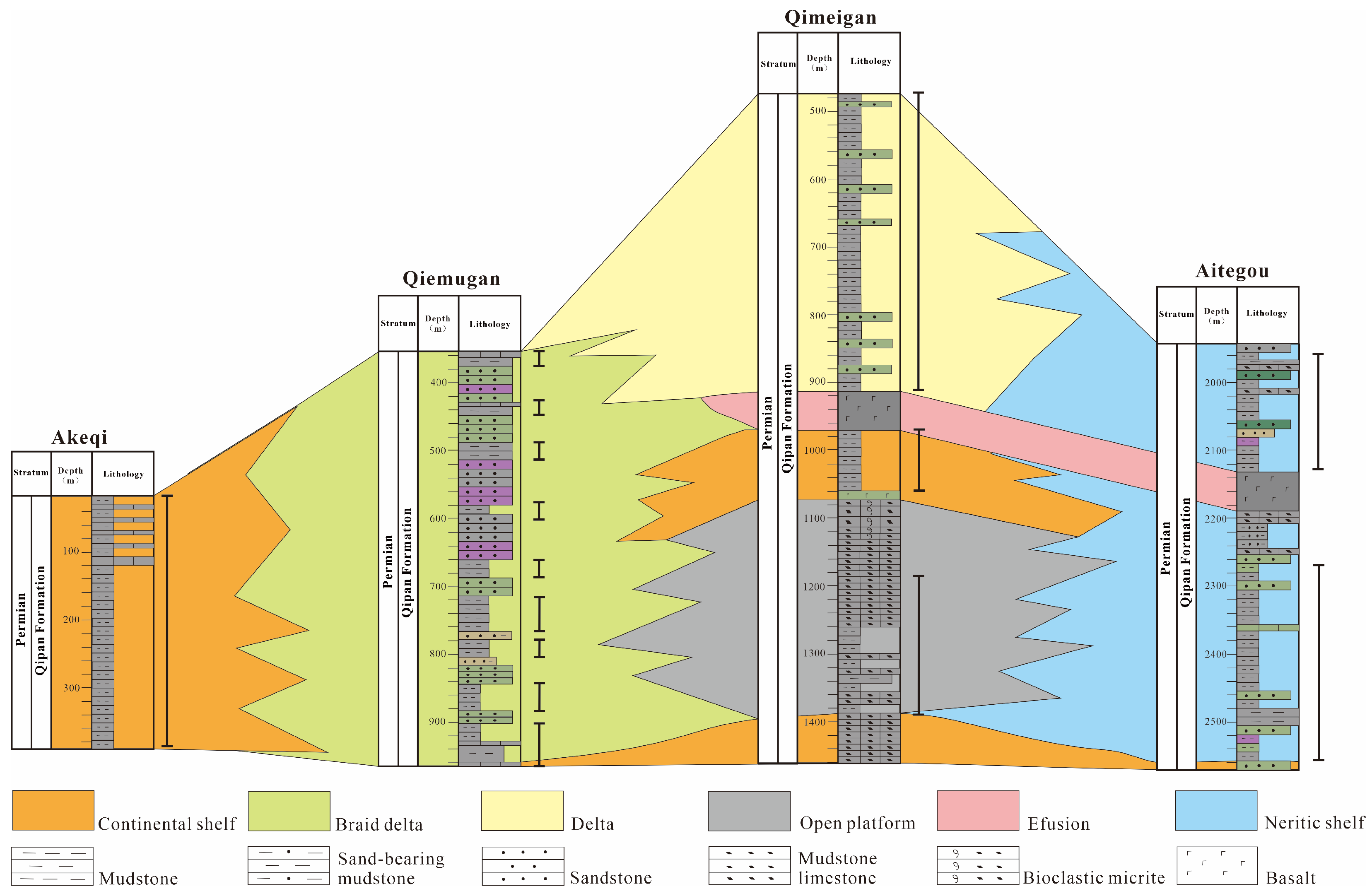
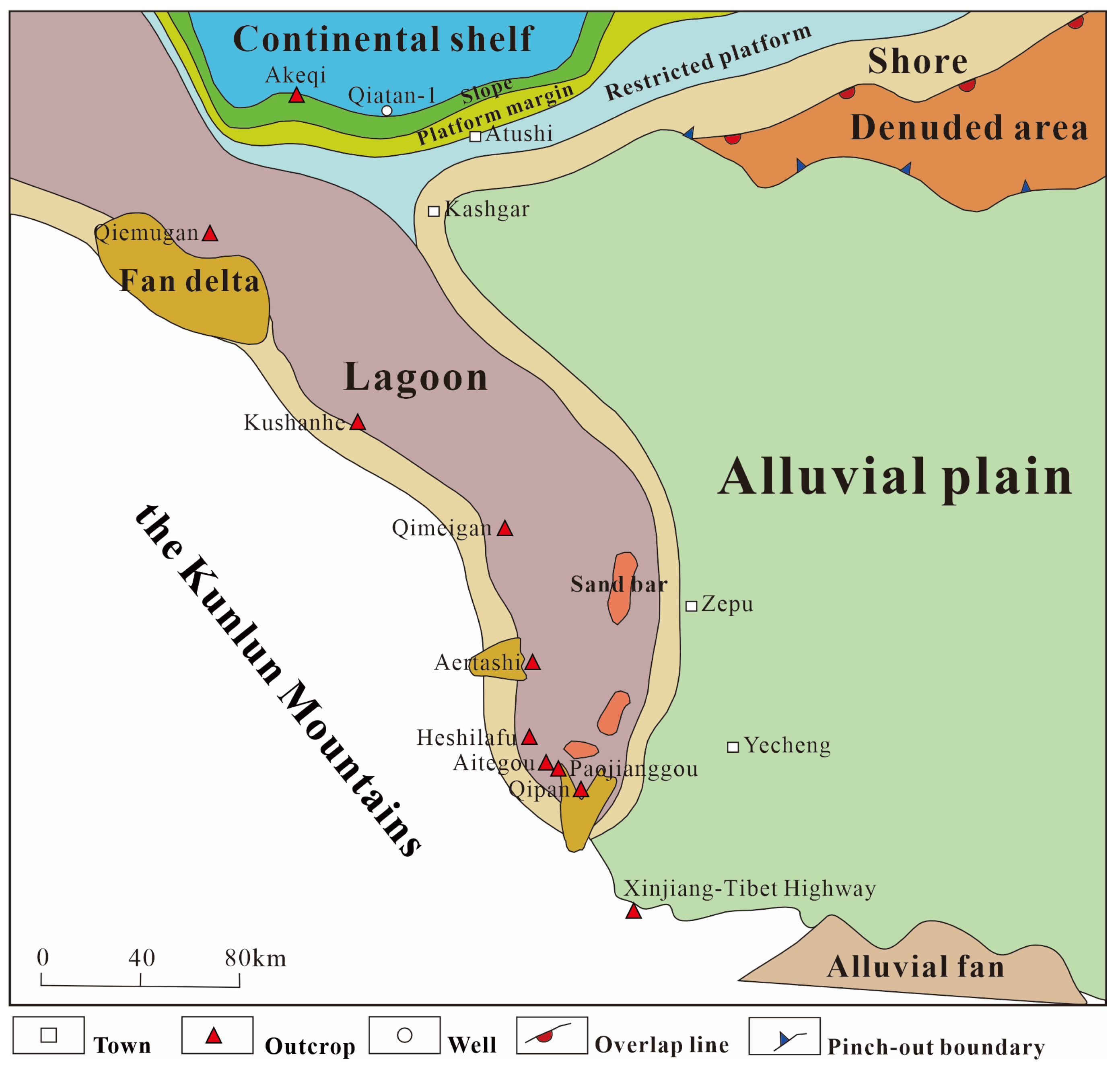
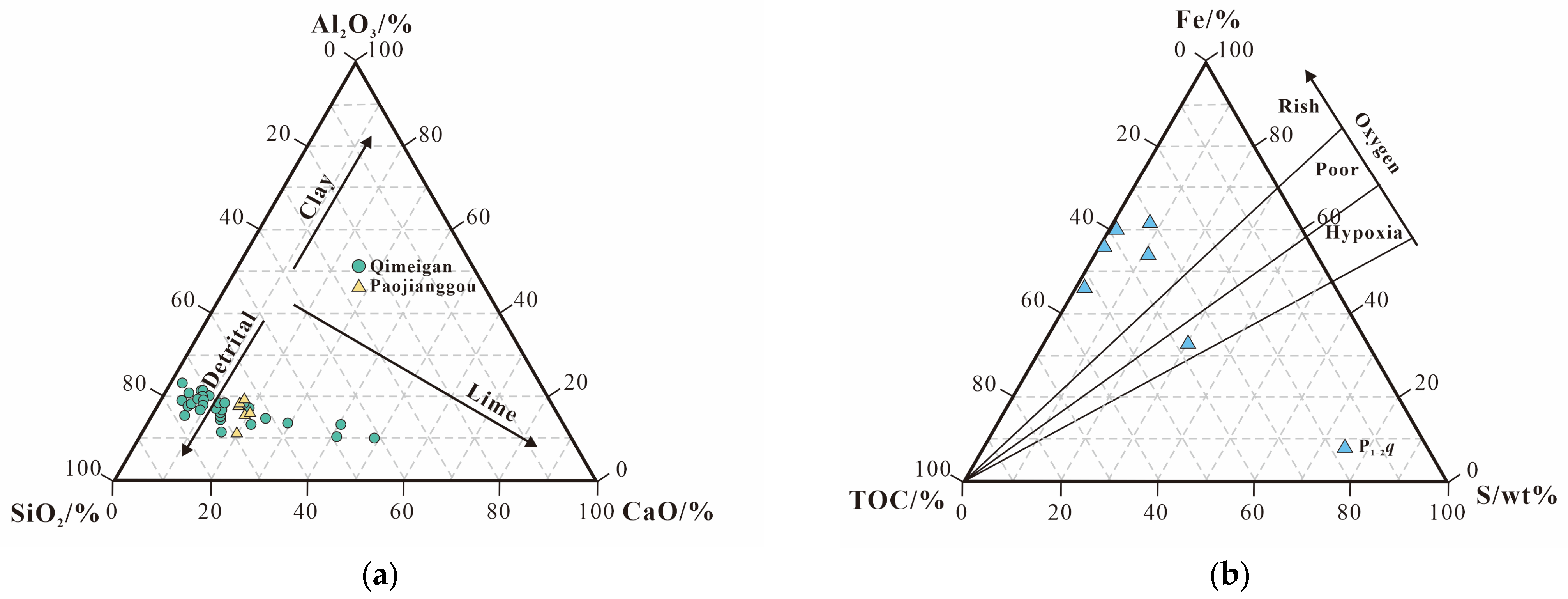


Disclaimer/Publisher’s Note: The statements, opinions and data contained in all publications are solely those of the individual author(s) and contributor(s) and not of MDPI and/or the editor(s). MDPI and/or the editor(s) disclaim responsibility for any injury to people or property resulting from any ideas, methods, instructions or products referred to in the content. |
© 2024 by the authors. Licensee MDPI, Basel, Switzerland. This article is an open access article distributed under the terms and conditions of the Creative Commons Attribution (CC BY) license (https://creativecommons.org/licenses/by/4.0/).
Share and Cite
Wu, Q.; Zhou, G.; Yin, J.; Ye, L.; Wang, Z. Geochemical Characteristics and Depositional Environment from the Permian Qipan Formation Hydrocarbon Source Rocks in the Piedmont of Southwestern Tarim Basin. Appl. Sci. 2024, 14, 8634. https://doi.org/10.3390/app14198634
Wu Q, Zhou G, Yin J, Ye L, Wang Z. Geochemical Characteristics and Depositional Environment from the Permian Qipan Formation Hydrocarbon Source Rocks in the Piedmont of Southwestern Tarim Basin. Applied Sciences. 2024; 14(19):8634. https://doi.org/10.3390/app14198634
Chicago/Turabian StyleWu, Qiong, Guoxiao Zhou, Jie Yin, Lin Ye, and Zhenqi Wang. 2024. "Geochemical Characteristics and Depositional Environment from the Permian Qipan Formation Hydrocarbon Source Rocks in the Piedmont of Southwestern Tarim Basin" Applied Sciences 14, no. 19: 8634. https://doi.org/10.3390/app14198634




